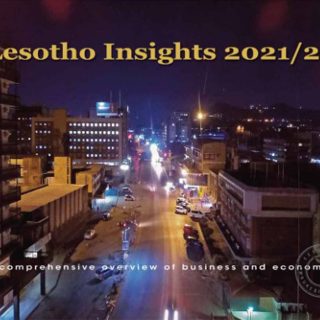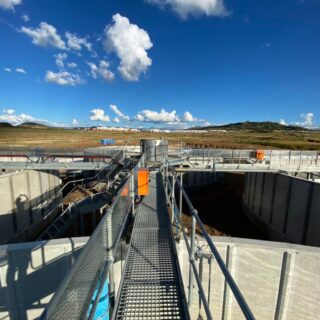Lesotho’s Minerals and Mining Policy

Writes Manyathela Kheleli
The vision of the Ministry of Mining is to provide for responsible and globally competitive exploitation of the country’s mineral resources in a manner that results in sustainable socio-economic benefits for the country. This vision is premised on the principle that the sovereignty and ownership of mineral resources are vested on the Basotho nation. Lesotho’s minerals and mining policy also seeks to advance the equitable, optimal and sustainable exploitation of the country’s mineral resources through domestic empowerment and integration, as well as participatory and inclusive approach of the Basotho nation.
In 2012, the government of Lesotho established a fully-fledged Ministry of Mining in recognition of the growing importance of the Mining Sector in the national economy. Largely dominated by diamond mining, the sector is expected to contribute more than 10% to the country’s GDP in the foreseeable future. The Lesotho mining sector, is perhaps the country’s best kept secret. Despite the country having an estimated 405 kimberlite bodies, only a few of these are currently being mined on a commercial scale. The country has 39 known and recorded kimberlite pipes and 366 kimberlite blows and dykes in total, of which 24 have been shown to be diamondiferous.
The history of diamond mining in Lesotho can be traced back to 1967, when an artisanal miner, Ernestine Ramaboa unearthed a brown coloured diamond that came to be known as the Lesotho Brown weighing 601 carats. The diamond was found at Letseng-la-Terae, where the present day Letšeng Mine is now found. In 1968, the diamond was purchased through an auction by an American jeweler Harry Winston. A fitting epilogue to the story is that Winston invited the Ramaboas to New York City for the unveiling and cleaving of the diamond. The moment was broadcast on live television across the United States (Balfour, 1981). The Lesotho Brown rough yielded 18 diamonds, including the Lesotho I, a flawless 71.73 ct diamond, and the Lesotho III, a 40.42 ct marquise purchased by Aristotle Onassis and given to Jacqueline Kennedy as an engagement ring.
Having identified the potential of Letšeng-La-Terai as a diamond minefield, full scale mechanized mining was eventually undertaken by De Beers when Letšeng Diamond mine was officially opened in November 1977 at a cost of more than R30 million (US$37 million), it went at least M6 million ($7.4 million) over its intended budget. In 1982, De Beers decided to close operations because the cost of running Letšeng had become untenable, largely because of its remoteness and what De Beers argued to be very low ore grade, which made production costs very high. For its five years of operation, De Beers’s production totaled 272,840 carats recovered from processing 9.4 million tons of kimberlite at the Main pipe, for a grade of 3.03 carats per hundred metric tons. About 65% of the output was gem quality, while 27% was industrial and 8% was bort (suited for crushing into abrasives). Only 7.6% of the production was larger than 14.7 ct, yet these accounted for 62% of the mine’s revenue (Venter, 2003).
Currently, there are about five operational diamond mines in the country. The biggest players in the industry include the same Letšeng diamond mine (Letšeng Diamonds), now operated by Gem Diamonds. Letšeng, is the world’s highest-dollar-per carat mining operation and the highest diamond mine in the world at 3200m above sea level. Another record for Letšeng Diamond mine is that the has grown to become one of the largest open pit diamond mines in the world, processing ore from two kimberlite pipes, the main pipe spanning over 17 hectares and a satellite pipe spreading over 5.2 hectares. At the moment, Letšeng Diamond mine is estimated to produce around just over 150, 000 carats per annum. Gem Diamonds took over the mine through the purchase of JCI–Matodzi shares at over M900 million in July 2006.
Liqhobong Diamond Mine operated by Firestone Diamonds boasts not only the largest capital investment in the country’s mining industry history at M2.1 billion, but also the largest production capacity of 1 million carats per annum for at least 15 years of its mining lease agreement. At that production level, Liqhobong will more than quadruple the current productivity in the diamond mining industry.
Kao mine operated by Storm Mountain Diamonds(Pty) Ltd (SMD) is another diamond mine in the District of Botha Bothe. SMD is jointly owned by Namakwa Diamonds Limited and the Government of Lesotho. The Government of Lesotho holds 25% of the free carry shares in SMD and the operations are entirely funded by Namakwa Diamonds Limited.
The Kao deposit consists of two kimberlite pipes, the main pipe (19.8 ha) and a satellite pipe (3.8 ha), located 350 metres north-west of the main pipe. The main pipe is the focus of the current mining operations and it has a resource of around 142 meters, indicated and inferred, containing an estimated 9 million carats at an average grade of 6.5 carats per hundred tons. Kao Mine, produces around 260,000 carats per annum.
The other diamond mine in Lesotho is Mothae Mine, owned by Lucapa Diamond Company Limited with 70 percent shares and the government of Lesotho with the remaining 30 percent. The mine is listed in the Australian Securities Exchange (ASX), with a secondary listing on the Frankfurt Stock Exchange. Lucapa’s second high-value mine, Mothae kimberlite project in diamond-rich Lesotho, commenced production in January 2019.
Lesotho mines, notably Letšeng, continue to find some of the world’s biggest and precious diamonds to date. In keeping with its history as the highest dollar per carat kimberlite diamond mine in the world, Letšeng continues to produce some of the world’s best diamonds. In the month of May 2021 alone, the mine produced a 254 and a 370 carat Type II diamonds. In 2020, the mine reported a recovery of 16 diamonds over 100 carats.
There still exists a grey area in the position of Government on artisanal and small scale mining. Characterized by minimal machinery and physical labour, artisanal mining generally operates without legal mining titles and valid contracts and is often limited to marginal plots. In 2020/21, the Minister of Mining, Serialong Qoo announced a grace period to collect and register illegally mined diamonds so that they can be certified and sold in formal markets. About 400 diamonds were collected from Basotho artisanal miners and the ministry has committed to sell the diamonds on behalf of the miners without imposing any levies or taxes. This move forms part and parcel of the Mining Policy to address abject poverty in the rural communities. The move is also a demonstration that Government recognizes that artisanal mining can contribute to job creation and increasing disposable income, thereby increasing local purchasing power and stimulating economic growth, particularly in the rural areas. In its policy statement, the Mining Policy intends to transform and reposition the artisanal mining sub-sector.
Lesotho’s mineral resource potential is not only limited to diamonds. There are significant occurrences of clays with potential for the clay industry to thrive in the country. Significant deposits of heavy clays, white-firing clays and stoneware clays have been identified. Lesotho is already mining formations of sandstone for the construction industry, and even exporting the produce to other countries in the region. The presence of fine-grained basalt and massive dolerites provide a good base for the dimension stone industry. Sporadic and small occurrences of a variety of semi-precious stones such as agate, chert, rock crystal amethyst, olivine zircon and chrome diopside are known to exist. There are also possible occurrences of base metals, precious metals and rare earth minerals. These deposits warrant a detailed geochemical exploration to confirm the viability and possible commercial exploitation. To that end, the Mining Policy commits Government to establish well-resourced geological survey agency that will carry out geological, geochemical and geophysical surveys of the country and regularly update the country’s geological databank.
References
- https://www.gia.edu/gems-gemology/fall-2015-letseng-unique-diamond-proposition
- The Minerals & Mining Policy 2015 – Ministry of Mining







